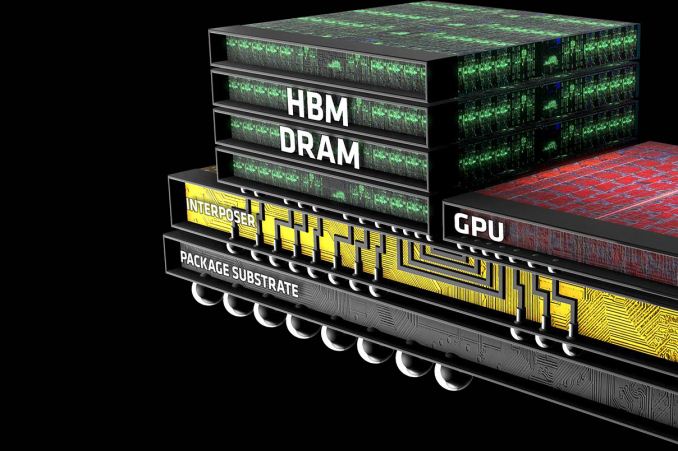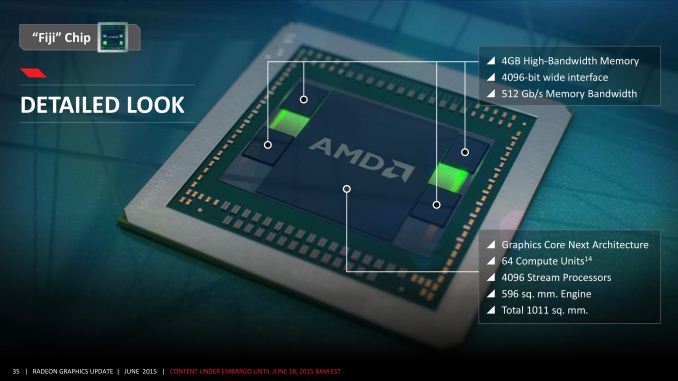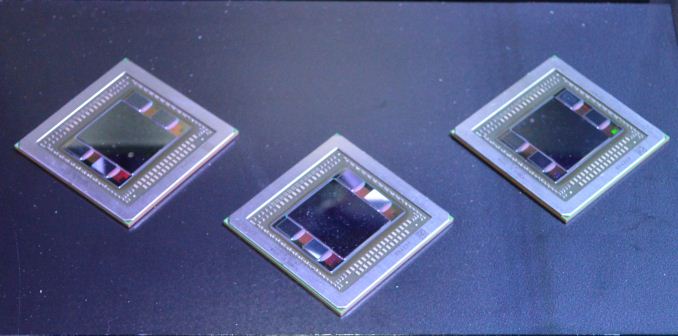The AMD Radeon R9 Fury X Review: Aiming For the Top
by Ryan Smith on July 2, 2015 11:15 AM ESTThe Fiji GPU: Go Big or Go Home
Now that we’ve had a chance to take a look at the architecture backing Fiji, let’s talk about the Fiji GPU itself.
Fiji’s inclusion of High Bandwidth Memory (HBM) technology complicates the picture somewhat when talking about GPUs. Whereas past GPUs were defined by the GPU die itself and then the organic substrate package it sits on, the inclusion of HBM requires a third layer, the silicon interposer. The job of the interposer is to sit between the package and the GPU, serving as the layer that connects the on-package HBM memory stacks with the GPU. Essentially a very large chip without any expensive logic on it, the silicon interposer allows for finer, denser signal routing than organic packaging is capable of, making the ultra-wide 4096-bit HBM bus viable for the first time.
We’ll get to HBM in detail in a bit, but it’s important to call out the impact of HBM and the interposer early, since they have a distinct impact on how Fiji was designed and what its capabilities are.
As for Fiji itself, Fiji is unlike any GPU built before by AMD, and not only due to the use of HBM. More than anything else, it’s simply huge, 596mm2 to be precise. As we mentioned in our introduction, AMD has traditionally shied away from big chips, even after the “small die” era ended, and for good reason. Big chips are expensive to develop, expensive to produce, take longer to develop, and yield worse than small chips (this being especially the case early-on for 40nm). Altogether they’re riskier than smaller chips, and while there are times where they are necessary, AMD has never reached this point until now.
The end result is that for the first time since the unified shader era began, AMD has gone toe-to-toe with NVIDIA on die size. Fiji’s 596mm2 die size is just 5mm2 (<1%) smaller than NVIDIA’s GM200, and more notably still hits TSMC’s 28nm reticle limit. TSMC can’t build chips any bigger than this; Fiji is as big a chip as AMD can order.
| AMD Big GPUs | ||||
| Die Size | Native FP64 Rate | |||
| Fiji (GCN 1.2) | 596mm2 | 1/16 | ||
| Hawaii (GCN 1.1) | 438mm2 | 1/2 | ||
| Tahiti (GCN 1.0) | 352mm2 | 1/4 | ||
| Cayman (VLIW4) | 389mm2 | 1/4 | ||
| Cypress (VLIW5) | 334mm2 | 1/5 | ||
| RV790 (VLIW5) | 282mm2 | N/A | ||
Looking at Fiji relative to AMD’s other big GPUs, it becomes very clear very quickly just how significant this change is for AMD. When Hawaii was released in 2013 at 438mm2, it was already AMD’s biggest GPU ever for its time. And yet Fiji dwarfs it, coming in at 158mm2 (36%) larger. The fact that Fiji comes at the latter-half of the 28nm process’s life time means that such a large GPU is not nearly as risky now as it would have been in 2011/2012 (NVIDIA surely took some licks internally on GK110), but still, nothing else we can show you today can really sell the significance of Fiji to AMD as much as the die size can.
And the fun doesn’t stop there. Along with producing the biggest die they could, AMD has also more or less gone the direction of NVIDIA and Maxwell in the case of Fiji, building what is unambiguously the most gaming/FP32-centric GPU the company could build. With GCN supporting power-of-two FP64 rates between 1/2 and 1/16, AMD has gone for the bare minimum in FP64 performance that their architecture allows, leading to a 1/16 FP64 rate on Fiji. This is a significant departure from Hawaii, which implemented native support for ½ rate, and on consumer parts offered a handicapped 1/8 rate. Fiji will not be a FP64 powerhouse – its 4GB of VRAM is already perhaps too large of a handicap for the HPC market – so instead we get AMD’s best FP32 GPU going against NVIDIA’s best FP32 GPU.
AMD’s final ace up their sleeve on die size is HBM. Along with HBM’s bandwidth and power benefits, HBM is also much simpler to implement, requiring less GPU space for PHYs than GDDR5 does. This is in part due to the fact that HBM stacks have their own logic layer, distributing some of the logic on to each stack, and furthermore a benefit of the fact that the signaling logic that remains doesn’t have to be nearly as complex since the frequencies are so much lower. 4096-bits of HBM PHYs still takes up a fair bit of space – though AMD won’t tell us how much – but it’s notably lower than the amount of space AMD was losing to Hawaii’s GDDR5 memory controllers.
The end result is that not only has AMD built their biggest GPU ever, but they have done virtually everything they can to maximize the amount of die space they get to allocate to FP32 and rendering resources. Simply put, AMD has never reached so high and aimed for parity with NVIDIA in this manner.
Ultimately this puts Fiji’s transistor count at 8.9 billion transistors, even more than the 8 billion transistors found in NVIDIA’s GM200, and, as expected, significantly more than Hawaii’s 6.2 billion. Interestingly enough, on a relative basis this is almost exactly the same increase we saw with Hawaii; Fiji packs in 43.5% more transistors than Hawaii, and Hawaii packed in 43.9% more transistors than Tahiti. So going by transistors alone, Fiji is very much to Hawaii what Hawaii was to Tahiti.
Finally, as large as the Fiji GPU is, the silicon interposer it sits on is even larger. The interposer measures 1011mm2, nearly twice the size of Fiji. Since Fiji and its HBM stacks need to fit on top of it, the interposer must be very large to do its job, and in the process it pushes its own limits. The actual interposer die is believed to exceed the reticle limit of the 65nm process AMD is using to have it built, and as a result the interposer is carefully constructed so that only the areas that need connectivity receive metal layers. This allows AMD to put down such a large interposer without actually needing a fab capable of reaching such a large reticle limit.
What’s interesting from a design perspective is that the interposer and everything on it is essentially the heart and soul of the GPU. There is plenty of power regulation circuitry on the organic package and even more on the board itself, but within the 1011mm2 floorplan of the interposer, all of Fiji’s logic and memory is located. By mobile standards it’s very nearly an SoC in and of itself; it needs little more than external power and I/O to operate.













458 Comments
View All Comments
Socius - Thursday, July 2, 2015 - link
What people also overlook is the fact that the Fury X is using more power than the 980ti, for example, while benefiting from a reduction of 20w-30w from using HBM. So the actual power efficiency of the GPU is even lower than it shows.chizow - Thursday, July 2, 2015 - link
Yep, another great point. What overhead they got from HBM was quickly gobbled up in Fiji's "overclock" to hit 980Ti perf.Ryan Smith - Thursday, July 2, 2015 - link
The Fury X does not throttle at 65C. 65C is when the card begins ramping up the fan speed. It would need to hit 75C to start throttling, which given the enormous capacity of the cooler would be very hard to achieve.Zinabas - Friday, July 3, 2015 - link
Well that's just wrong, chart clearly shows "Total System Power" which has a 415w - 388w = 27w power difference between 980TI and Fury X. Reading is not your strong point.275w card vs. a 250w card... 25w difference, who knew math was so easy.
kn00tcn - Thursday, July 2, 2015 - link
are you supposed to beat it up? last time i checked, water cooling is rather expensive & limited, are you forgetting there are 2 more air cooled lower price launches coming?Socius - Thursday, July 2, 2015 - link
I wasn't saying to put it up against a water cooled gtx 980. I was saying a stock reference design gtx 980 when overclocked to the max, will be competitive with and possibly even beat the fury x when overclocked to the max.Also the 2 air cooled versions coming out will be using a cut down die.
Ryan Smith - Thursday, July 2, 2015 - link
To be clear here, we do not coordinate with Tom's in any way. I have not talked to anyone at Tom's about their review, and honestly I haven't even had a chance to read it yet. The opinions you see here reflect those opinions of AnandTech and only AnandTech.As for overclocking, I already answered this elsewhere, but we never do direct cross-vendor comparisons of OC'd cards. It's not scientifically sound, due to variance.
Finally, for video encoding, that test is meant to be representative of a high-end NLE, which will use GPU abilities to accelerate compositing and other effects, but will not use a fixed-function encoder like NVENC. When you're putting together broadcast quality video, you do not want to force encoding to take place in real time, as it may produce results worse than offline encoding.
mapesdhs - Friday, July 3, 2015 - link
The one plus side of doing roundup reviews of oc'd cards is that very quickly just about all available models *are* oc'd versions, and reference cards cost more, so such roundups are very useful for judging the performance, etc. of real shipping products as opposed to reference cards which nobody in their right mind would ever buy.ruthan - Thursday, July 2, 2015 - link
From this review is feel something like - they are trying, they are poor - we have to be kind to them. Ryan wrote that cooling is great, i read few other review were cooling was criticized, as noisy and incosistent - i know if there is also a bit of good heart instead of facts, or it differs card by card, but review samples are usualy more polished - if arent from some local it shop.AMD is very big company with lots of people with huge salaries for sake of our society we should be cruel to such big companies failures, but if they die, they will free the space and other companies could emerge.
Murloc - Thursday, July 2, 2015 - link
no because the barriers to entry in this market are just too huge, and handing a monopoly to nvidia would make such an entry even more difficult.